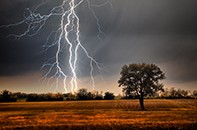A lightning strike victim
Electrical injuries may be divided into the three broad subgroups of lightning injuries, high-voltage (more than 1000 V) electrical injuries and low-voltage (below 1000 V) electrical injuries, with differences in the assessment and management of patients in each group. One example of the different management is that in patients in whom the electrical current provokes a cardiac arrest, cardiopulmonary resuscitation (CPR) is important in those struck by lightning whereas early defibrillation is important in those injured by generated electricity. This is because the cardiac arrest is more likely to be asystole from a lightning strike and ventricular fibrillation (VF) from a house- hold AC current. It is safe to perform CPR on victims of lightning strikes as they are not ‘charged’.
This article focuses on lightning injuries and discusses the case of a young man who is struck by lightning but does not sustain immediate severe injuries.
Picture credit: © Balazs Kovacs Images/Shutterstock.

